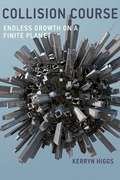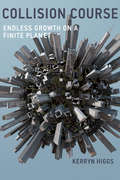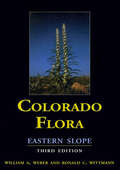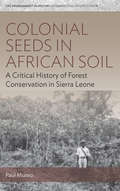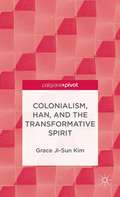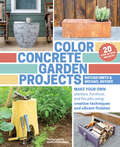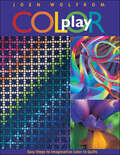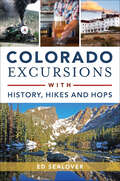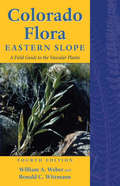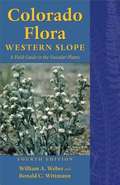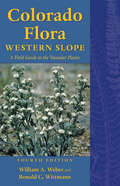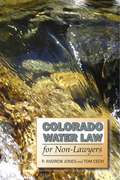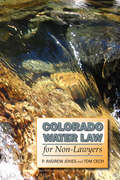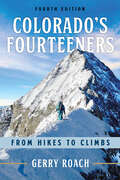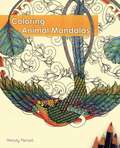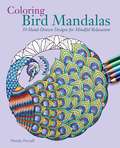- Table View
- List View
Collecting Rocks, Gems and Minerals: Identification, Values and Lapidary Uses (Warman's Field Guide Ser.)
by Patti PolkUnlike the dense and highly technical academic tomes that are text-heavy, poorly organized and intimidating, this colorful and easy-to-use reference guide dedicated to collecting rocks, gems and minerals is ideal for readers who want to expand their understanding without getting lost in a labyrinth of science. Beautifully illustrated with 700 color photographs providing wonderful detail and smartly organized to take the hassle out identification, you will enjoy the simplicity of the guide and the enthusiasm and knowledge of author Patti Polk, one of the top agate collectors in the world and a self-proclaimed "rockhound." You will also enjoy two areas that our competitors don't bother with. First it includes values, and second, it covers an introduction to lapidary, which is the cutting and polishing of rocks and gemstones for jewelry or display.
Collective Learning for Transformational Change: A Guide to Collaborative Action
by Valerie A. Brown Judith A. LambertThe drive for change has informed human endeavour throughout history. From fields to factories to offices, people have always asked how to make things better. This innovative book offers a step by step guide for recognising the need for transformational change and kick-starting a course of implementation that leads to the creation of a productive, just and sustainable future for the given community. Drawing on over 300 cases of transformational change planned-for and supported through the process of collective learning, the book shows how a collective learning model based on open learning among diverse interests can improve communication and achieve lasting system change. Part one of the book outlines the theory and practice of collective learning, drawing on the experiential learning cycle developed by David Kolb. The practice follows the rules of open space learning, dialogue and valuing diversity and is flexible, allowing adaptation to different situations. Case studies in Part two provide examples of collective learning leading to transformational change in a wide range of contexts, from cities to councils to organisations. Part three offers thirty-three activities on which the programme designers can draw in the course of guiding transformational change, from team building, to community development, monitoring, evaluation and cross-cultural learning This guidebook differs from the traditional management of change. Not only does the process begin with sharing ideals, only later proceeding to implementation, but it also actively harnesses the full set of interests in planning direct action, seeking constructive collaboration not consensus. This groundbreaking guidebook is designed to be fun, accessible and engaging for both students and professionals in the fields of administration and governance.
Collision Course
by Kerryn HiggsThe story behind the reckless promotion of economic growth despite its disastrous consequences for life on the planet.
Collision Course: Endless Growth on a Finite Planet (The\mit Press Ser.)
by Kerryn HiggsThe story behind the reckless promotion of economic growth despite its disastrous consequences for life on the planet.The notion of ever-expanding economic growth has been promoted so relentlessly that “growth” is now entrenched as the natural objective of collective human effort. The public has been convinced that growth is the natural solution to virtually all social problems—poverty, debt, unemployment, and even the environmental degradation caused by the determined pursuit of growth. Meanwhile, warnings by scientists that we live on a finite planet that cannot sustain infinite economic expansion are ignored or even scorned. In Collision Course, Kerryn Higgs examines how society's commitment to growth has marginalized scientific findings on the limits of growth, casting them as bogus predictions of imminent doom.Higgs tells how in 1972, The Limits to Growth—written by MIT researchers Donella Meadows, Dennis Meadows, Jorgen Randers, and William Behrens III—found that unimpeded economic growth was likely to collide with the realities of a finite planet within a century. Although the book's arguments received positive responses initially, before long the dominant narrative of growth as panacea took over. Higgs explores the resistance to ideas about limits, tracing the propagandizing of “free enterprise,” the elevation of growth as the central objective of policy makers, the celebration of “the magic of the market,” and the ever-widening influence of corporate-funded think tanks—a parallel academic universe dedicated to the dissemination of neoliberal principles and to the denial of health and environmental dangers from the effects of tobacco to global warming. More than forty years after The Limits to Growth, the idea that growth is essential continues to hold sway, despite the mounting evidence of its costs—climate destabilization, pollution, intensification of gross global inequalities, and depletion of the resources on which the modern economic edifice depends.
Colo Flora: East Slope
by William A. WeberReflecting the conclusions of current taxonomic research and recognizing new species found in the state, these thoroughly updated guides offer the most complete and authoritative reference to the plants of Colorado. Both volumes explain basic terminology; discuss plant geography; and describe special botanical features of the mountain ranges, basins, and plains. Interesting anecdotes and introductions are given for each plant family, and hints on recognizing the largest families are provided as well. Each volume includes a complete glossary, indices to common and specific names, and hundreds of illustrations. Ideal both for the student and scientist, Colorado Flora: Eastern and Western Slopes, Third Edition are essential for readers interested in Colorado's plant life.
Colo Flora: West Slope
by William A. Weber Ronald C. WittmannReflecting the conclusions of current taxonomic research and recognizing new species found in the state, these thoroughly updated guides offer the most complete and authoritative reference to the plants of Colorado. Both volumes explain basic terminology; discuss plant geography; and describe special botanical features of the mountain ranges, basins, and plains. Interesting anecdotes and introductions are given for each plant family, and hints on recognizing the largest families are provided as well. Each volume includes a complete glossary, indices to common and specific names, and hundreds of illustrations. Ideal both for the student and scientist, Colorado Flora: Eastern and Western Slopes, Third Edition are essential for readers interested in Colorado's plant life.
Colonial Seeds in African Soil: A Critical History of Forest Conservation in Sierra Leone (Environment in History: International Perspectives #18)
by Paul Munro“Empire forestry”—the broadly shared forest management practice that emerged in the West in the nineteenth century—may have originated in Europe, but it would eventually reshape the landscapes of colonies around the world. Melding the approaches of environmental history and political ecology, Colonial Seeds in African Soil unravels the complex ways this dynamic played out in twentieth-century colonial Sierra Leone. While giving careful attention to topics such as forest reservation and exploitation, the volume moves beyond conservation practices and discourses, attending to the overlapping social, economic, and political contexts that have shaped approaches to forest management over time.
Colonialism, Han, and the Transformative Spirit
by Grace Ji-Sun KimGlobalism, colonialism, and consumerism have caused unjust suffering (han), for the earth's exploited peoples and the exploited lands. To reverse this tragedy, we need to work for a safer, sustainable planet and renew our inspiration from God as the transforming Spirit who gives, sustains and empowers life to all.
Color Basics for Makers: Understanding the Rainbow
by Lee Chappell MonroeInteractive guide to understand and apply the fundamentals of color! Confidence is key when it comes to color! Join Lee Monroe as she shares the tips and tricks from her most popular art class useful for every crafter at any skill level. Using fine art and design knowledge, she shares an overview of color theory that demystifies the concepts. Learn the color fundamentals and get a clear understanding of how the saturation of the color pigment changes as white, black, or grey are added. Readers then explore what makes a successful palette and how different color combinations affect the mood of a finished piece. Try out the concepts in any medium with hands-on exercises and practical beginner-friendly projects. Elevate your art with a true understanding of color theory! Learn to select and use color with confidence with hands-on exercises that demystifies choosing and using colors For every crafter and artist! Work with fabrics, paint, embroidery, printmaking, colored pencils, and more Gain insight on how to combine colors, and find practical applications for identifying colors, values, and purity
Color Concrete Garden Projects: Make Your Own Planters, Furniture, and Fire Pits Using Creative Techniques and Vibrant Finishes
by Michael Snyder Nathan Smith Charles ColemanA Library Journal Best Crafts & DIY Book of 2015 Incorporating concrete design into a home garden can now be easily achieved by any do-it-yourself enthusiast! Concrete furniture and containers add style and personality to outdoor spaces, and the addition of color makes these objects even more eye-catching. These trendy pieces can cost thousands of dollars at garden centers and furniture stores, but they can also be made affordably at home. In this hands-on guide, concrete artisans Nathan Smith and Michael Snyder offer basic information on how to mix concrete and add color using dyes, paints, and inlaid materials. The twenty step-by-step projects include small items, like a candle holder with an old-world feel and a simple stacked-ring planter, and larger pieces, like an elegant bike rack and a beautiful fire pit that is the perfect gathering place for friends and family.
Color Play: Easy Steps to Imaginative Color in Quilts
by Joen WolfromJoen Wolfrom broadens your color experience and stretches your imagination with creative color play. Now selecting colors for your quilt designs will be fun, and your quilts will always live up to their visual potential! • Chapters featuring 24 colors, their characteristics, and the combinations that make them look fabulous in a quilt design • Sample fabric arrangements make color concepts easy to understand • Learn about color “scales” - the variations of pure color, tints, shades, and tones - and how they affect the mood of a quilt • Stunning nature photography helps you relate to the dynamic colors of summer, the fragile hues of spring, and more! • A luscious gallery of over 70 colorful quilts illustrates Joen’s techniques for choosing colors • Irresistible illusions you can create using color - highlights, shadows, depth, transparency, and more
Color War! (Camp Sunnyside Friends #3)
by Marilyn KayeThe girls in Cabin 6 end up on the same team in the annual color war. This year, some of them are assigned to a different team, splitting the cabin into. The girls become aggressive, and the strain to win threatens their friendship. The girls have to decide what's more important: the war or their friendship.
Colorado Excursions with History, Hikes and Hops (History And Guide Ser.)
by Ed SealoverExperience Colorado&’s history, beauty, and award-winning breweries with this travel guide featuring ten weekend excursions. Full of fascinating history and natural beauty, Colorado also boasts a thriving craft beer culture. In this informative guide, author Ed Sealover offers a series of itineraries that combine all three. Colorado Excursions with History, Hikes and Hops features ten three-day excursions full of nature, historic sites, and unique watering holes. Discover sprawling parks and celebrated landmarks throughout the state. Visit oddball destinations like the trail of America's favorite cannibal and the renowned ghost town of Saint Elmo. Work up a thirst on the hiking trails of Rocky Mountain National Park and unwind on the single block in the state that is home to a brewery, a winery, and a distillery. Uncover the craft, creative and cultural gems that make the Centennial State a curious wanderer&’s dream.
Colorado Family Outdoor Adventure: An All-Ages Guide to Hiking, Camping, and Getting Outside (Southwest Adventure Series)
by Heather MundtColorado Family Outdoor Adventure is the definitive guide for families of all ages to experiencing the natural splendors of Colorado. Whether you are planning your first family adventure or you are an experienced outdoors family, Heather Mundt provides everything parents, grandparents, children, and teenagers need to know to enjoy activities throughout the state. As an experienced outdoors writer, adventurer, and family traveler, Mundt shares more than sixty destinations across Colorado, outlining family adventures in hiking, biking, paddling, horseback riding, whitewater rafting, camping, skiing, sledding, rockhounding, wildlife watching, fishing, climbing, enjoying cultural activities, and more in this go-to guide.Every one of these outdoor activities is graded in terms of difficulty and age-appropriateness, so every reader will know exactly which activities are right for their young kids, teens, and older relatives. Organized geographically with easy-to-use maps alongside detailed descriptions and beautiful photography, Colorado Family Outdoor Adventure explores every corner of the state with memory-making activities for every family.
Colorado Flora: Eastern Slope, Fourth Edition <br>A Field Guide to the Vascular Plants
by William A. Weber Ronald C. WittmannColorado Flora: Eastern Slope describes the remarkable flora of the state, distinctive in its altitudinal range, numerous microhabitats, and ancient and rare plants. Together with Colorado Flora: Western Slope, Fourth Edition, these volumes are designed to educate local amateurs and professionals in the recognition of vascular plant species and encourage informed stewardship of our biological heritage. These thoroughly revised and updated editions reflect current taxonomic knowledge. The authors describe botanical features of this unparalleled biohistorical region and its mountain ranges, basins, and plains and discuss plant geography, giving detailed notes on habitat, ecology, and range. The keys recount interesting anecdotes and introductions for each plant family. The book is rounded out with historical background of botanical work in the state, suggested readings, glossary, index to scientific and common names, references, and hundreds of illustrations. The books also contain a new contribution from Donald R. Farrar and Steve J. Popovich on moonworts. The fourth editions of Colorado Flora: Eastern Slope and Colorado Flora: Western Slope are ideal for both student and scientist and essential for readers interested in Colorado's plant life.
Colorado Flora: Western Slope
by William A. Weber Ronald C. Wittmann[C]learly a book that every Rocky Mountain botanist should own." -Arctic and Alpine Research Colorado Flora: Eastern Slope describes the remarkable flora of the state, distinctive in its altitudinal range, numerous microhabitats, and ancient and rare plants. Together with Colorado Flora: Western Slope, Fourth Edition, these volumes are designed to educate local amateurs and professionals in the recognition of vascular plant species so that they can be better stewards of our priceless and irreplaceable biological heritage. These thoroughly revised and updated editions reflect current taxonomic knowledge. The authors describe botanical features of this unparalleled biohistorical region and its mountain ranges, basins, and plains and discuss plant geography, giving detailed notes on habitat, ecology, and range. The keys contain interesting anecdotes and introductions for each plant family. Each volume includes a background of botanical work in the state, a complete glossary, indices to common and scientific names, references and suggested readings, and hundreds of illustrations. The books also contain a new contribution from Donald R. Farrar and Steve J. Popovich on moonworts. The fourth editions of Colorado Flora: Eastern Slope and Colorado Flora: Western Slope are ideal for both student and scientist and essential for readers interested in Colorado's plant life.
Colorado Flora: Western Slope, Fourth Edition <br>A Field Guide to the Vascular Plants
by William A. Weber Ronald C. WittmannColorado Flora: Western Slope describes the remarkable flora of the state, distinctive in its altitudinal range, numerous microhabitats, and ancient and rare plants. Together with Colorado Flora: Eastern Slope, Fourth Edition, these volumes are designed to educate local amateurs and professionals in the recognition of vascular plant species and encourage informed stewardship of our biological heritage. These thoroughly revised and updated editions reflect current taxonomic knowledge. The authors describe botanical features of this unparalleled biohistorical region and its mountain ranges, basins, and plains and discuss plant geography, giving detailed notes on habitat, ecology, and range. The keys contain interesting anecdotes and introductions for each plant family. The book is rounded out with historical background of botanical work in the state, suggested readings, glossary, index to scientific and common names, references, and hundreds of illustrations. The books also contain a new contribution from Donald R. Farrar and Steve J. Popovich on moonworts. The fourth editions of Colorado Flora: Eastern Slope and Colorado Flora: Western Slope are ideal for both student and scientist and essential for readers interested in Colorado's plant life.
Colorado Flora: Western Slope, Third Edition
by William A. Weber Ronald C. WittmannReflecting the conclusions of current taxonomic research and recognizing new species found in the state, these thoroughly updated guides offer the most complete and authoritative reference to the plants of Colorado. Both volumes explain basic terminology; discuss plant geography; and describe special botanical features of the mountain ranges, basins, and plains. Interesting anecdotes and introductions are given for each plant family, and hints on recognizing the largest families are provided as well. Each volume includes a complete glossary, indices to common and specific names, and hundreds of illustrations. Ideal both for the student and scientist, Colorado Flora: Eastern and Western Slopes, Third Edition are essential for readers interested in Colorado's plant life.
Colorado Water Law for Non-Lawyers
by Tom Cech P. Andrew JonesWhy do people fight about water rights? Who decides how much water can be used by a city or irrigator? Does the federal government get involved in state water issues? Why is water in Colorado so controversial? These questions, and others like them, are addressed in Colorado Water Law for Non-Lawyers. This concise and understandable treatment of the complex web of Colorado water laws is the first book of its kind. Legal issues related to water rights in Colorado first surfaced during the gold mining era of the 1800s and continue to be contentious today with the explosive population growth of the twenty-first century. Drawing on geography and history, the authors explore the flashpoints and water wars that have shaped Colorado's present system of water allocation and management. They also address how this system, developed in the mid-1800s, is standing up to current tests - including the drought of the past decade and the competing interests for scarce water resources - and predict how it will stand up to new demands in the future. This book will appeal to non-lawyers involved in water quality issues, students, and attorneys and water professionals desiring a succinct and readable summary of Colorado water law, as well as general readers interested in Colorado's complex water rights law.
Colorado Water Law for Non-Lawyers
by Tom Cech P. Andrew JonesWhy do people fight about water rights? Who decides how much water can be used by a city or irrigator? Does the federal government get involved in state water issues? Why is water in Colorado so controversial? These questions, and others like them, are addressed in Colorado Water Law for Non-Lawyers. This concise and understandable treatment of the complex web of Colorado water laws is the first book of its kind. Legal issues related to water rights in Colorado first surfaced during the gold mining era in the 1800s and continue to be contentious today with the explosive population growth of the twenty-first century. Drawing on geography and history, the authors explore the flashpoints and water wars that have shaped Colorado’s present system of water allocation and management. They also address how this system, developed in the mid-1800s, is standing up to current tests—including the drought of the past decade and the competing interests for scarce water resources—and predict how it will stand up to new demands in the future. This book will appeal to at students, non-lawyers involved with water issues, and general readers interested in Colorado’s complex water rights law.
Colorado's Backyard Wildlife: A Natural History, Ecology, & Action Guide to Front Range Urban Wildlife
by Carol Ann MoorheadIntroduces a variety of animals and habitats that exist along Colorado's Front Range. Ages 12 and up.
Colorado's Fourteeners: From Hikes to Climbs
by Gerry RoachStandard, alternate, and technical routes for all 58 Colorado Fourteener peaks A classic guidebook known for its accuracy and comprehensiveness, Colorado's Fourteeners has been updated for this thirtieth anniversary edition to include GPS coordinates, revised topographic maps, expanded route details, and new descriptions reflecting alterations to trail access. Besides the often-climbed standard routes, the guide describes many alternative and technical routes.The trusted source for over 30 years, this is the guide to bring with you to peaks websites can't reach.
Coloring Animal Mandalas
by Wendy PiersallAttain focus, clarity and peace while adding bright and inspiring colors to these unique patternsFrom the Sanskrit word for "circle," mandalas have been used for meditation and healing for thousands of years. Coloring Animal Mandalas adds the beauty of the animal kingdom-including butterflies, tigers, swans, snakes, lions, and even dragons-into these intricate designs for page after page of coloring book bliss.With roots in Hinduism and Buddhism, mandalas are spiritual symbols that represent the universe. Coloring these hypnotically beautiful, mystical shapes is a meditative and enjoyable way to relax. A fun way to achieve a state of mindfulness, Coloring Animal Mandalas adds fosters creativity, reduces stress, and allows you to embrace your inner child by focusing on the simple but engaging task of coloring in the detailed designs.
Coloring Bird Mandalas: 30 Hand-drawn Designs for Mindful Relaxation
by Wendy PiersallYOUR FAVORITE NEW HOBBY—COLORING FOR FUN AND RELAXATION—GETS AN AVIAN TWIST WITH THIS COLLECTION OF WHIMSICAL MANDALASRelax, focus, reach a higher state of mindfulness and simply enjoy yourself as you artistically fill in the intricate shapes. Coloring Bird Mandalas offers you an imaginative array of avian images, including:• Toucans• Flamingos• Parrots• Peacocks• Hummingbirds• Owls• Finches
Colors of Nature: Culture, Identity, and the Natural World
by Deming, Alison; Savoy, Lauret“An anthology of nature writing by people of color, providing deeply personal connections to—or disconnects from—nature.” —NPRFrom African American to Asian American, indigenous to immigrant, “multiracial” to “mixed-blood,” the diversity of cultures in this world is matched only by the diversity of stories explaining our cultural origins: stories of creation and destruction, displacement and heartbreak, hope and mystery.With writing from Jamaica Kincaid on the fallacies of national myths, Yusef Komunyakaa connecting the toxic legacy of his hometown, Bogalusa, LA, to a blind faith in capitalism, and bell hooks relating the quashing of multiculturalism to the destruction of nature that is considered “unpredictable”—among more than thirty-five other examinations of the relationship between culture and nature—this collection points toward the trouble of ignoring our cultural heritage, but also reveals how opening our eyes and our minds might provide a more livable future.Contributors: Elmaz Abinader, Faith Adiele, Francisco X. Alarcón, Fred Arroyo, Kimberly Blaeser, Joseph Bruchac, Robert D. Bullard, Debra Kang Dean, Camille Dungy, Nikky Finney, Ray Gonzalez, Kimiko Hahn, bell hooks, Jeanne Wakatsuki Houston, Pualani Kanaka’ole Kanahele, Robin Wall Kimmerer, Jamaica Kincaid, Yusef Komunyakaa, J. Drew Lanham, David Mas Masumoto, Maria Melendez, Thyllias Moss, Gary Paul Nabhan, Nalini Nadkarni, Melissa Nelson, Jennifer Oladipo, Louis Owens, Enrique Salmon, Aileen Suzara, A. J. Verdelle, Gerald Vizenor, Patricia Jabbeh Wesley, Al Young, Ofelia Zepeda“This notable anthology assembles thinkers and writers with firsthand experience or insight on how economic and racial inequalities affect a person’s understanding of nature . . . an illuminating read.” —Bloomsbury Review“[An] unprecedented and invaluable collection.” —Booklist


